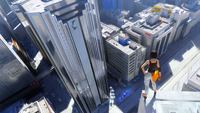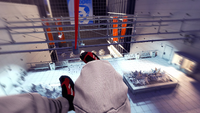(the person who plays Faith Connors.) Tags: Visual edit apiedit |
Tag: sourceedit |
||
| Line 35: | Line 35: | ||
To increase the duration of the game, there are many messenger bags hidden in the levels for the player to find and unlock extras, as well as a time trial mode, in which players try to complete small parts of a level in the fastest time possible. Scorecards online, as well as red "ghost riders", allow the player to view the fastest routes or routes from other players in scorecards. |
To increase the duration of the game, there are many messenger bags hidden in the levels for the player to find and unlock extras, as well as a time trial mode, in which players try to complete small parts of a level in the fastest time possible. Scorecards online, as well as red "ghost riders", allow the player to view the fastest routes or routes from other players in scorecards. |
||
| + | |||
| + | ==External Links== |
||
| + | *http://www.mirrorsedge.com/ |
||
[[Category:Media]] |
[[Category:Media]] |
||
Revision as of 16:00, 18 October 2015
Overview
Mirror's Edge is a single-player first-person action-adventure video game, developed and published by EA Digital Illusions CE (DICE) and Electronic Arts respectively, which was initially released on November 12, 2008. On January 15, 2009, a version was released for Windows.
The game was announced on July 10, 2007 and runs on the Unreal Engine 3, with the addition of a new lighting solution, developed by DICE. The game has a realistic style, is brightly colored and quite different from most first-person perspective video games, allowing a wide range of actions and greater freedom of movement via parkour.
A demo was released on the PlayStation Store on October 30 and on Xbox Live on October 31 of 2008. It consists of the tutorial training level of the compound and one opening level.
Synopsis

"Once the city used to pulse with energy. Dirty and dangerous, but alive and wonderful. Now it's something else."
The game takes place in an unnamed, gleaming, "utopian" City where everything is regulated and controlled by the City regime. To transmit information without alerting the government, so called Runners, including the protagonist Faith Connors (model Noelle Lynn), are commissioned.
During the events of the game, a popular politician, Robert Pope, is murdered. Faith and her sister, Kate Connors, are then subsequently targeted by the City Protection Force. While Kate is arrested, Faith manages to escape. As the story progresses, she tries to unravel the circumstances of Pope's murder and to relieve her sister.
Gameplay

Art of parkour
Mirror's Edge is intended to convey realism and physical contact with the environment, and instill a freedom of movement never before seen in the first-person genre. This is achieved not only by freely moving around the stage, but also by linking the movement of the camera with character movement, such as the speed at which the camera moves up and down to increase as Faith builds up momentum while running or turn the camera rolling when Faith does a barrel roll after landing. Moreover, the arms, legs, and torso are prominent and visibility is used to transmit motion and momentum, such as when Faith's arms go up and down and her increased stride length when walking.
With this important movement in approach, it is essential to maintain momentum, which can be used to make chains of movements. Failure to perform these movements together cause a loss of momentum, which can cause Faith not achieve the necessary amount thereof to scale an object. Controls can perform different actions depending on the context in which it is used. The "up" button will cause Faith crosses an avoiding it at the top obstacle (e.g. jumping, climbing or using props to form a chain of movements that help you cross the obstacle above), while the "down" button will cause it traverse obstacles along the bottom, like sliding, rolling or simply bending.
To assist the player in creating these chains of moves, the game uses a system called "Runner Vision", which gets its name from its purpose: to describe the environment in the way a Runner would see it, recognizing escape routes immediately. It is a system that highlights objects by painting them red as Faith approaches them. Such objects are useful for progress, such as pipes, ramps, accessible doors, etc. This system does not always indicate the best way to go, however. Later in the game, the number of these visual clues are limited to the final goal, although the player can choose to disable this system completely. It is also used to create puzzles where the player must solve the problem of how to use the objects featured in a stage to achieve a string of movements to reach the objective. Another mechanism to assist the player is a system called "Reaction Time"; a slow motion mode that allows time for the player to plan where to go and then also to facilitate the regulation of jumps and disarmament.
To increase the duration of the game, there are many messenger bags hidden in the levels for the player to find and unlock extras, as well as a time trial mode, in which players try to complete small parts of a level in the fastest time possible. Scorecards online, as well as red "ghost riders", allow the player to view the fastest routes or routes from other players in scorecards.